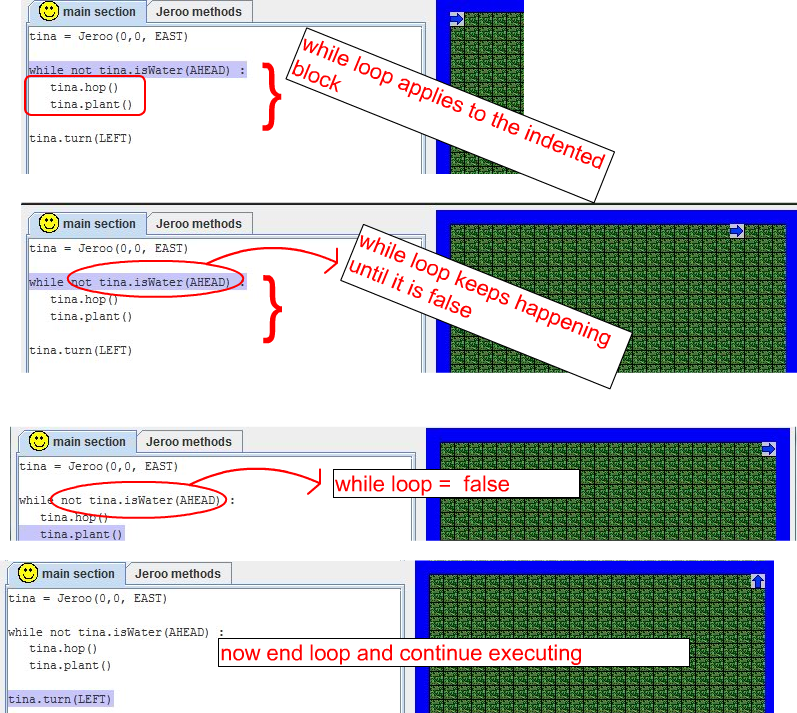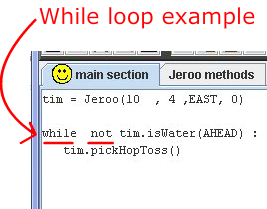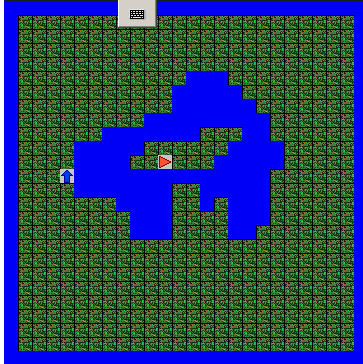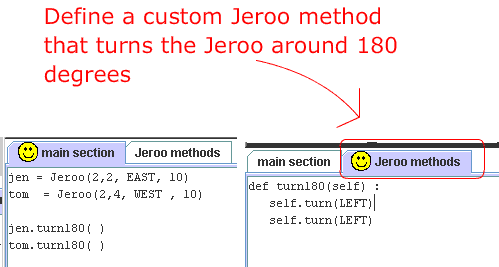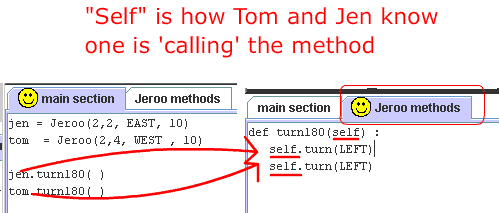Author Archives: Mr. M
Jeroo Python While Loop
custom method go around lake
Objective: Make a jeroo walk around the perimeter of the lank, on the land side. Use a custom method
download the island file
Class Relationships involving interfaces and Abstract Classes
Two Caveats
- all instance variables must be explicitly written as “private”
- Declare ArrayList’s as type “list”:
The classes below represent different ways of representing mathematical concepts like MathExpressions, Fractions etc. and they all implement the Mathable interface.
public abstract class GraphicalMathObject
methods
- public abstract void displayGraphicalRepresentation() ;
public class Fraction extends GraphicalMathObject
This class is used to represent Fractions
Instance Variables
- private int numerator
- private int denominator
Constructor : The constructor should initialize both instance variables
- public Fraction(int num, int denom)
Methods
- public void displayGraphicalRepresentation() ; (just print out ” I’m a fraction -displayGraphicalRepresentation()”. This is the method that renders a graphical representation of the fraction .

- private int getGCF() //returns the GCF of numerator and denominator
- public void simplify()//simplifies the fraction. Note: you must call getGCF()
- public Fraction clone() //return a clone of the current object (** Extra credit…research this) ( link )
- plus all of the methods in Mathable (Described at bottom)

public class MathExpression extends GraphicalMathObject
This is a class that is used to represent mathematical expressions like 3x2or 5x2y2 . It contains the methods and variables described below and it must implement Mathable
Instance Variables
- private int coefficient
- private List<String> variables
- private List<Integer> powers
NOTE: you should use the following sytnax
Declare ArrayList’s as type “list”:
Constructor : You can decide how to write the constructor.
- Just be sure to initialize the instance variables
methods implement all methods of the Mathable Interface in ways that make sense for this class. The idea with Mathable is that you should be able to tell if the objects are either equivalent, exactly the same and that you should be able to return a String representation (data) that uniquely identifies the given mathematical expression.
-
public void addTerm( String term , int power) ) // This is used to represent multiplication, actually and this method adds a term with a power to the object’s list of
variablesand power to the list ofpowers. You can not assume that the term does not yet exist in the expression .
For instance, if the original term were 3x5 and the object called addTerm("y", 6) the object would then be 3x5y6. Or for another example, if the original term is 2x3z6 , and addTerm("z", 5) the object would be 2x3z11 . - public void displayGraphicalRepresentation() ; (just print out “I”m a MathExpression.: displayGraphicalRepresentation()”). This is the method that draws the MathExpression on the screen like:
- plus all of the methods in Mathable
Examples
| 3x2y5 |
coefficient: 3 variables : [ “x”, “y”] powers : [ 2, 5] |
| x1y11 |
coefficient: 1 variables : [ “x”, “y”] powers : [ 1, 11] |
| 3y2x5 |
coefficient: 3 variables : [ “y”, “x”] powers : [ 5 , 2] |
Interface : Mathable
- public String getData( ) ; represents core mathematical information that defines current object.
- public boolean exactlyEquals(Mathable other) ;
- public boolean isEquivalent(Mathable other) ;
Walk the Lake (custom Method)
|
|

The Betrothal
The Betrothal

Intro To Java Assignments (2013-14)
Arrays II
- Arrays in Demo
- Test : June 10th/11th (Arrays and two dimensional arrays)
- Two Dimensional Arrays
- The problem with Arrays
- Array 2 (codingbat) Do any 18 questions. You can get extra credit for doing any of the last 4. EOD Sunday May 31st
- All students must do sum67
- Array Fun 2 (due by EOD Tuesday May 13rd )
- Array Fun 1 (email to me by EOD Tuesday May 6th)
Arrays
- short circuiting
- Array 1 Coding Bat type questions
- default values of arrays
- arrays in memory(value vs reference)
- swapping values in an array without creating a new array like this coding bat problem–assuming you didn’t make a new array
- Coding Bat : Array 1 (Thursday April 24th-that’s day of the 2nd class after the April break)
- Short Circuiting
April 2nd
- Test (April 2nd/3rd)
- All coding bat warm up and String 1’s must be completed by then
- Strings immutable, codingbat.com
Strings (the basics)
String Cheat Sheet

String str ="ABCDEFG"
String firstLetter = str.substring(0,1)
String firstTwoLetters = str.substring(0,2)
String lastLttr = str.substring(str.length() -1)
String last_2_lttrs = str.substring(str.length() -2 )
String middle_lttr = str.substring(str.length()/2 , str.length()/2 +1)
Unit 2
- Introduction to Strings
- String Assignments #1
- Coding Bat – Warm up 1 (now do the ones involving Strings)
- Coding Bat -STrings 1
Extra credit: Looping over Strings
- String Loops Review (word doc) **
- String Loops 1
- String Loops 2 (must do)
- String Projects #1 do the (Validate User Input Project)
- testcases_validate_form
- Required Coding Bat Problems
- Some Practice Problems
Unit I
Deadline the day you return from feb break
- Coding Bat
- Warm up I – Skip all things that have to do with Strings (for now)
- Logic 1 – (all)
- logic 2 ( any 5)
Midterm Quiz
*Wed/Thursday 21st/22nd
- definitions:
- pass by value
- pass by reference
- C++ memory usage (see last asssessment) . Yes, pretty much same questions with different numbers
- floating point error
- understand of whether the following data types are pass by value vs reference in Java
- int
- double
- boolean
cross-the-bridge
Objective: Your goal is get your jeroo onto the right side of the island. Note that the red areas are nets. You must toss() a flower onto the net before you can go on the net.. You will need the following island file .

Walk-the-lake
Monsoon rains have created a lake in the middle of Santong Island. Furthermore, that lake contains an island. Two Jeroos were separated by the rains. One is on the main part of Santong Island, but the other is on the island in the middle of the lake. The goal of this program is to have each Jeroo explore the shoreline of the lake.
- Each Jeroo starts with one flower and the lake immediately to its right.
- Each Jeroo starts by planting a flower then traveling, keeping the lake on its right, until it returns to the flower. The Jeroo then picks the flower.
- (only plant 1 flower, at starting point…and make 1 lap until you are back at that flower)
- Have the Jeroo on the main part of Santong Island walk the shore first.
- then have the one on the lake’s island walk the shore
Download Walk the Lake (This has several maps, choose any 1)
Acknowledgement
This problem is adapted from one that was created originally by Erica Eddy of The University of Wisconsin – Parkside.
Or you can try walk the lake using loops using this map and Jeroo assignment
Jeroo Custom Methods
Do you ever wish that you could make your Jeroo turn around 180 degrees?
Example 2 of a Custom Method to “Go Around a net”
You can download the files for the animation below here

